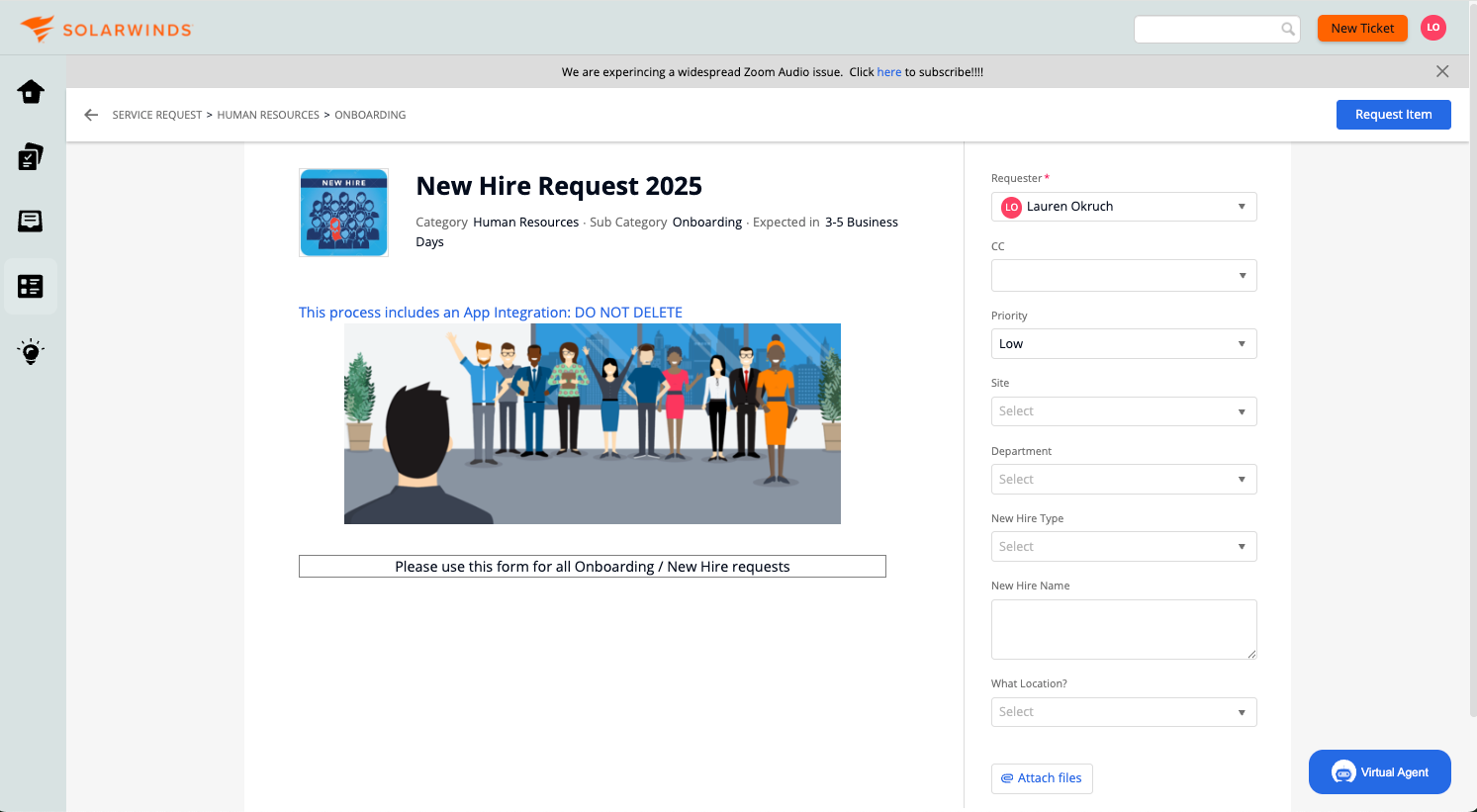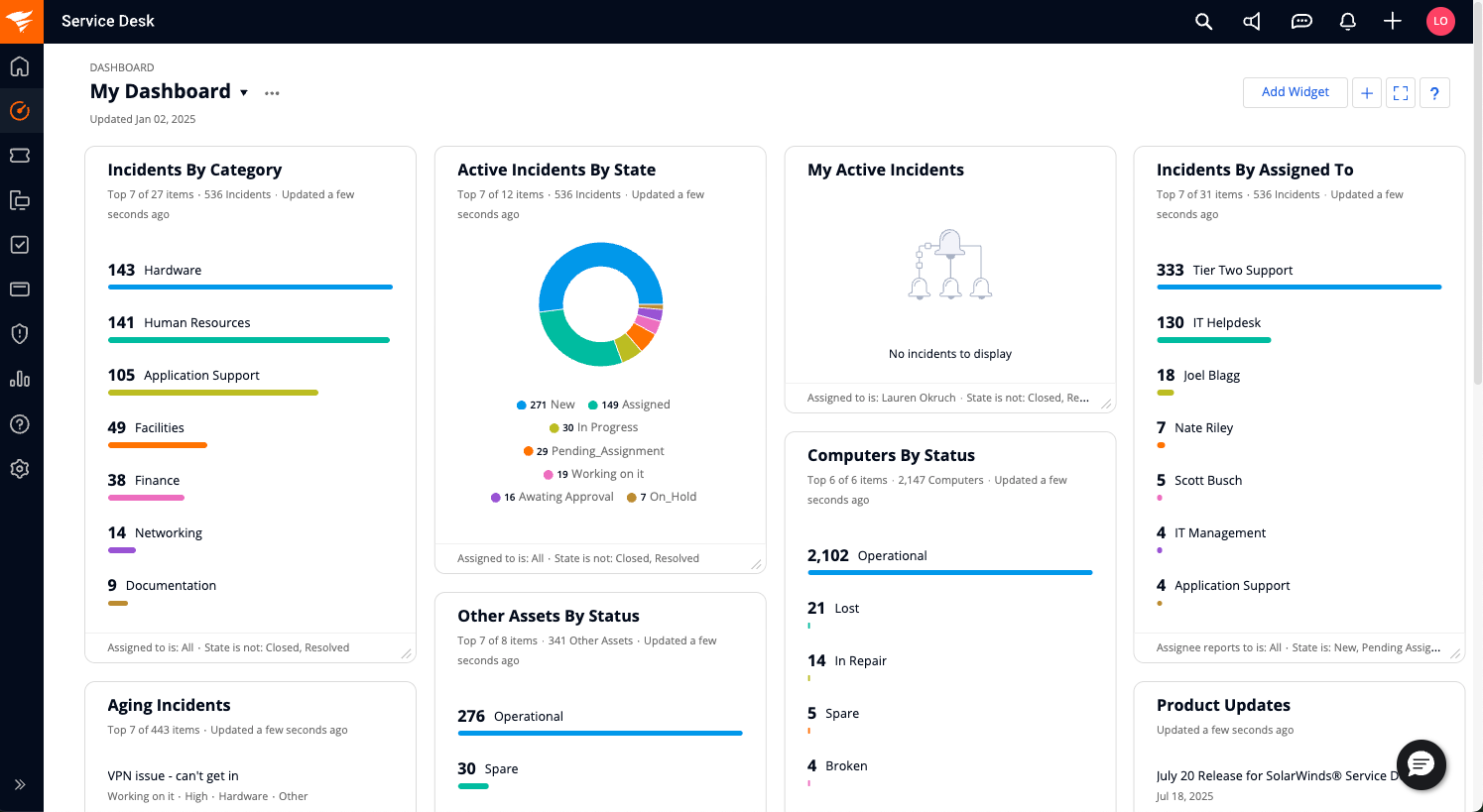Boosting Productivity with an Optimized ITSM Ticketing System
IT service management processes revolve around addressing a need or resolving an issue. A workflow tracking system or ITSM ticketing system becomes essential to effectively oversee these activities.
Similar to how an air or train ticket facilitates travel, an ITSM ticket facilitates workflow tracking. For example, it can track the information and status of a service request, change, incident, problem, release, configuration item, or any other ITSM element based on pre-determined workflows and agreed service levels. The ticket record provides history and serves as a reference for future decision-making and improvement through analysis.
An ITSM ticketing system ensures that IT tasks are assigned, tracked, and fulfilled efficiently to meet the expected quality. It acts as both an engagement and communication tool for the digital workforce and offers the accountability required for IT service management and delivery across the organization.
An ITSM ticketing system leads to greater consistency and control within ITSM processes. This article explores the expected functionality of modern ITSM ticketing systems. along with practical tips and emerging trends.
Summary of key ITSM ticketing system functionality
Functionality | Explanation |
|---|---|
Ticket creation | Allows initiation from various self-service or agent-managed facilities such as portals, email, phone, walk-in, or monitoring systems. |
Ticket assignment | Preconfigured workflows or manual interventions route tickets to assigned agents based on category, source, and other information. |
Ticket status | Tracks the ticket through the various states in the handling lifecycle based on set timelines or SLAs. |
Ticket escalation | Allows manual and automatic ticket routing to more specialized or skilled staff, third-party vendors, or management based on intervention required due to status or SLA violation. |
Ticket relating | Links tickets to various ITSM elements, including other tickets, IT assets, and knowledge articles that support issue handling. |
Ticket reporting | Generates reports highlighting the status, performance, and end-customer satisfaction at designated periods. |
Ticket creation
In ITSM ticketing systems, the interaction that triggers ticket creation comes from a person or an automated system.
Self-service portal
ITSM ticketing systems should include self-service portals that allow end users to review a catalog of options, select what they require, and then submit it to a support team for action. Portals act as a single point of contact and support the “shift left” concept by empowering users to submit requests themselves and find resources, such as knowledge articles, to address them.
Where users are uncomfortable with portals, other channels that can be routed into a ticketing system include contacting IT support staff directly (by walk-in, phone call, or social media) and having them create the ticket themselves. IT staff can also create tickets directly on the ITSM ticketing systems to report issues or plan tasks.

Automated ticket creation
Your ticketing system should allow users to trigger automated ticket creation through email, other textual channels, or IT monitoring systems. The process is as follows:
- A user types freeform text and attaches supporting information to an email addressed to a particular IT support mailbox linked to the ITSM ticketing system.
- A rule captures the pertinent information and generates a ticket automatically.
- The user receives an email confirming ticket creation and can add more information if necessary.
IT monitoring systems integrated with ITSM ticketing tools should create tickets through API calls based on pre-configured rules. For example, a network link that has surpassed a capacity threshold triggers an alert on the IT monitoring system and creates a proactive incident ticket assigned to the relevant IT network administrators.
Enforce ITSM policies
Whenever a ticket is created, the IT ticketing system should automatically generate the date and time stamp and a unique identifier for each submitted ticket. It should also include pertinent information to support assignment and handling based on relevant ITSM policies and processes.
You should be able to configure the ITSM ticketing systems so that tickets can only be submitted when specific mandatory fields are populated. Examples of compulsory data include issue descriptions, requester details, issue categories, and supporting data such as attachments or screenshots.
Ticket assignment
Once a ticket is created, the next step is to assign it to the relevant IT staff based on the request or issue type.
Pre-configured workflows
The ITSM ticketing system should manage automatic assignments through preconfigured workflows based on the catalog entry specifications for straightforward tickets launched from the portal. For example:
- Request for access or standard item: The ticket is assigned to the requester’s line manager (and other higher-ups depending on the sensitivity or value of the requested item) for approval and then to the relevant IT team queue for fulfillment as per the SLA.
- Issue affecting a single user: The ticket is assigned to the predefined first-line IT support staff for handling.
- Request for IT infrastructure change: The ticket is assigned to the change manager for review and routing to the relevant change authorities.

Powerful Support Made Simple
Revolutionize support with an AI-powered ticketing system. Leverage smart automation and intelligent ticket routing to resolve issues faster than ever before.
Automatic reassignment
Ideally, the system routes the ticket to a queue managed by an IT team to be handled based on the initial categorization. For user issues, it routes the ticket to first-line support for handling or further routing to other specialist teams.
When an IT support staff member takes up the ticket for processing, the assignment leaves the group queue and becomes listed under the said staff member so that other team members do not work on the same issue.
The IT support staff can route it to other team members where required, but this is guided by internal rules to ensure that quality and end-user satisfaction is not compromised by the ticket bouncing between members.
The IT staff assigned to the ticket should also be able to analyze and enrich the submitted information with additional data, such as contextual information or prioritization (based on impact, urgency, workload, or other agreed-upon parameters). Contextual information can be sourced from the requestor, other IT support team members, or other third-party sources. It can include updated request handling rules, associated issues or components, and clarifications. Where required, the system should reassign tickets based on this additional information.
Ticket lifecycle status
The ITSM ticketing system should track ticket progression from creation to closure through status changes. For instance, it can mark the entire progression in the ticket’s lifecycle through various statuses, like those below.
Status | Meaning |
|---|---|
Draft | The ticket is being created but is yet to be submitted. The requester may save the ticket and return later to populate it. |
New | The ticket has been submitted to the IT support organization. |
Open | The ticket is in the relevant IT support team’s queue for assigning. |
In Progress | The ticket has been assigned to the relevant IT support team member for action. |
On Hold | The ticket has been paused temporarily pending further information (from the requester or a third party), approvals, or resource allocation. |
Resolved | The relevant IT support team member has addressed the ticket and is awaiting the requester's confirmation. |
Closed | The requester has accepted the ticket resolution, or sufficient time has passed with no response following resolution. |
Reopened | A closed ticket has been reactivated due to the resolution being discovered as unacceptable or for other reasons. |
Cancelled | The requester no longer requires the need to be fulfilled, or the context around the issue has changed. |
Ticket progression through the lifecycle can be manual or automated, depending on the ITSM ticketing system configuration, internal policies, and working methods. The IT support team working on the ticket plays the most prominent role in the status change. By picking the ticket from the team’s queue, they own it from resolution to closure.
The ITSM ticketing system should also trigger status changes determined by an organization’s agreed service levels. For instance, it can assign tickets in a round-robin fashion instead of waiting in a queue or close them within a set timeline if there is no activity post-resolution. Finally, the requester can progress a ticket to closure if the circumstances around the issue have changed to void the need for action.
Configured SLAs in the ITSM ticketing system impact ticket status, as their computation is directly linked to the timelines between statuses. Status monitoring becomes crucial in meeting set targets, satisfying customers or users, and optimizing resource allocation. You should be able to configure the ITSM ticketing system to trigger interventions based on ticket status to meet SLAs. For example, it could generate alerts when a status has changed multiple times (bouncing between open and assigned) or when nearing a set SLA threshold for assignment or resolution.
Ticket escalation
For organizations with a tiered or leveled structure based on competence and specialization, the ticket is first handled by the first point of contact (least cost, lowest expertise). The ticket is reassigned to a higher level with the required expertise if challenges are encountered. Escalation occurs when the time taken to handle a ticket indicates that the agreed service level targets are unlikely to be met.
The ITSM ticketing system should trigger escalations when set SLAs are likely to be surpassed or when the individual assigned to the ticket realizes that they cannot effectively handle the issue raised. This involves manual or automatic ticket routing to more specialized or skilled staff, third-party vendors, or management.
You should also be able to configure the ITSM ticketing system to send notifications to relevant parties (the requestor, assignees, and escalated parties) whenever escalation is triggered. The system should notify IT team leadership (hierarchical escalation) whenever critical issues such as significant downtimes or degradation have not been resolved within a certain period. It does not reassign the ticket itself but may update it with details about the leadership communication.
Ticket relating
As the ITSM ticketing system is part of an ecosystem, it should be able to link tickets with other ITSM process elements. Tickets can be related to similar or different ticket types where an association is relevant for the IT support teams. Examples of such ticket-to-ticket relationships include:
Ticket type | Reason for linking | How it helps |
|---|---|---|
Duplicate tickets | Multiple tickets were raised by one or more users concerned with the same issue. | IT support teams can be more efficient by recording remedial actions in only one ticket. |
Parent-child tickets | One ticket relates to a core issue or activity; other tickets are subordinate tasks created to support the initial ticket. | Provides a structured way to manage complex tasks, track progress of sub-tasks, and ensure all related work is completed. |
Cause-and-effect tickets | Relates to events, incidents, problems, and change request tickets. One or more incidents can be related to a problem due to a shared root cause. | Allows for better root cause analysis, faster problem resolution, and prevents future incidents by linking related events and changes. |
Tickets can also be related to associated IT assets and configuration items, which can significantly enhance the planning and operation of IT services and their underlying components. For example,
- Linking incident tickets to a faulty hardware module allows the IT team to investigate similar modules as part of root cause analysis.
- Linking change request tickets to the configuration items to better inform change impact assessment and identify other related systems that could be affected by the change.
- Linking tickets to assets allows the IT support team to better plan the required maintenance, replacement, and retirement activities for associated components.
Another ticket relationship relevant to ITSM is linking tickets with knowledge articles. The knowledge base is a useful repository where IT teams can document valuable information on products and services, including user manuals, troubleshooting guides, FAQs, and configuration standards. Linking tickets with associated knowledge articles equips IT teams to handle assigned tasks better and resolve issues faster while growing the capabilities and expertise of less experienced team members.
Ticket reporting
ITSM ticketing systems should deploy reporting mechanisms to provide a comprehensive picture of ticket handling status and performance within a service delivery organization. Ideally, you want to process the raw ticket data, apply filters and calculations, and present the results through summary tables, charts, and dashboards. The ticketing system should make standard and customized report options available for users to quickly generate and analyze reports, diagnose issues, and track key metrics based on ITSM-related events, including incidents, service requests, change requests, problems, assets, configuration items, and suppliers.
Some of the reports expected from ITSM ticketing systems include:
- Count and percentage of tickets based on categories and status.
- Performance against SLA targets, such as response and resolution timelines.
- Customer satisfaction based on ticket ratings.
- Workload based on tickets handled by IT staff.
- Compliance based on ticket content and handling.

Apart from in-built reporting mechanisms, ITSM ticketing systems should also come with integration capabilities that allow ticket data exporting to third-party business reporting tools. Through API interfaces, ticket data can be transferred to business intelligence and analytics tools to be enriched with other business data (such as finance, procurement, HR, etc.) and visualized through dashboards to support executive decision-making.
Last thoughts
A well-configured ticketing system enables IT support teams to be accurate, consistent, and structured in their approach to service delivery. From an operational excellence perspective, ITSM ticketing systems will support the broader IT ecosystem as long as the enterprise demands quality services from IT. Such systems continue to evolve through improved automation and integration, especially with the enhancements driven by generative AI.


